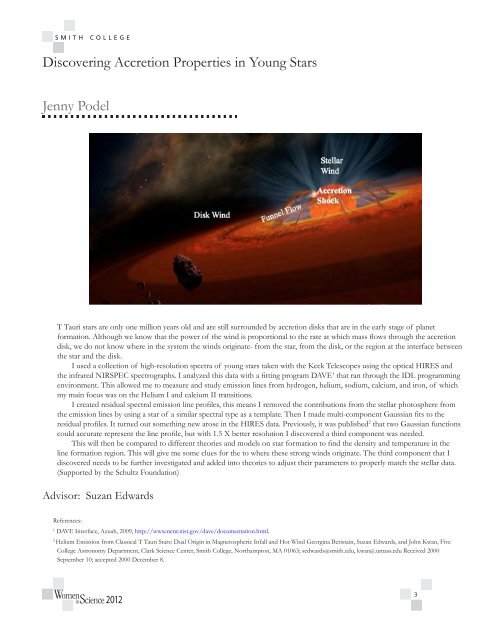Brugia Malayi - Clark Science Center - Smith College
Brugia Malayi - Clark Science Center - Smith College
Brugia Malayi - Clark Science Center - Smith College
You also want an ePaper? Increase the reach of your titles
YUMPU automatically turns print PDFs into web optimized ePapers that Google loves.
Discovering Accretion Properties in Young Stars<br />
Jenny Podel<br />
T Tauri stars are only one million years old and are still surrounded by accretion disks that are in the early stage of planet<br />
formation. Although we know that the power of the wind is proportional to the rate at which mass flows through the accretion<br />
disk, we do not know where in the system the winds originate- from the star, from the disk, or the region at the interface between<br />
the star and the disk.<br />
I used a collection of high-resolution spectra of young stars taken with the Keck Telescopes using the optical HIRES and<br />
the infrared NIRSPEC spectrographs. I analyzed this data with a fitting program DAVE 1 that ran through the IDL programming<br />
environment. This allowed me to measure and study emission lines from hydrogen, helium, sodium, calcium, and iron, of which<br />
my main focus was on the Helium I and calcium II transitions.<br />
I created residual spectral emission line profiles, this means I removed the contributions from the stellar photosphere from<br />
the emission lines by using a star of a similar spectral type as a template. Then I made multi-component Gaussian fits to the<br />
residual profiles. It turned out something new arose in the HIRES data. Previously, it was published 2 that two Gaussian functions<br />
could accurate represent the line profile, but with 1.5 X better resolution I discovered a third component was needed.<br />
This will then be compared to different theories and models on star formation to find the density and temperature in the<br />
line formation region. This will give me some clues for the to where these strong winds originate. The third component that I<br />
discovered needs to be further investigated and added into theories to adjust their parameters to properly match the stellar data.<br />
(Supported by the Schultz Foundation)<br />
Advisor: Suzan Edwards<br />
References:<br />
1<br />
DAVE Interface, Azuah, 2009, http://www.ncnr.nist.gov/dave/documentation.html.<br />
2<br />
Helium Emission from Classical T Tauri Stars: Dual Origin in Magnetospheric Infall and Hot Wind Georgina Beristain, Suzan Edwards, and John Kwan, Five<br />
<strong>College</strong> Astronomy Department, <strong>Clark</strong> <strong>Science</strong> <strong>Center</strong>, <strong>Smith</strong> <strong>College</strong>, Northampton, MA 01063; sedwards@smith.edu, kwan@.umass.edu Received 2000<br />
September 10; accepted 2000 December 8.<br />
2012<br />
3

















